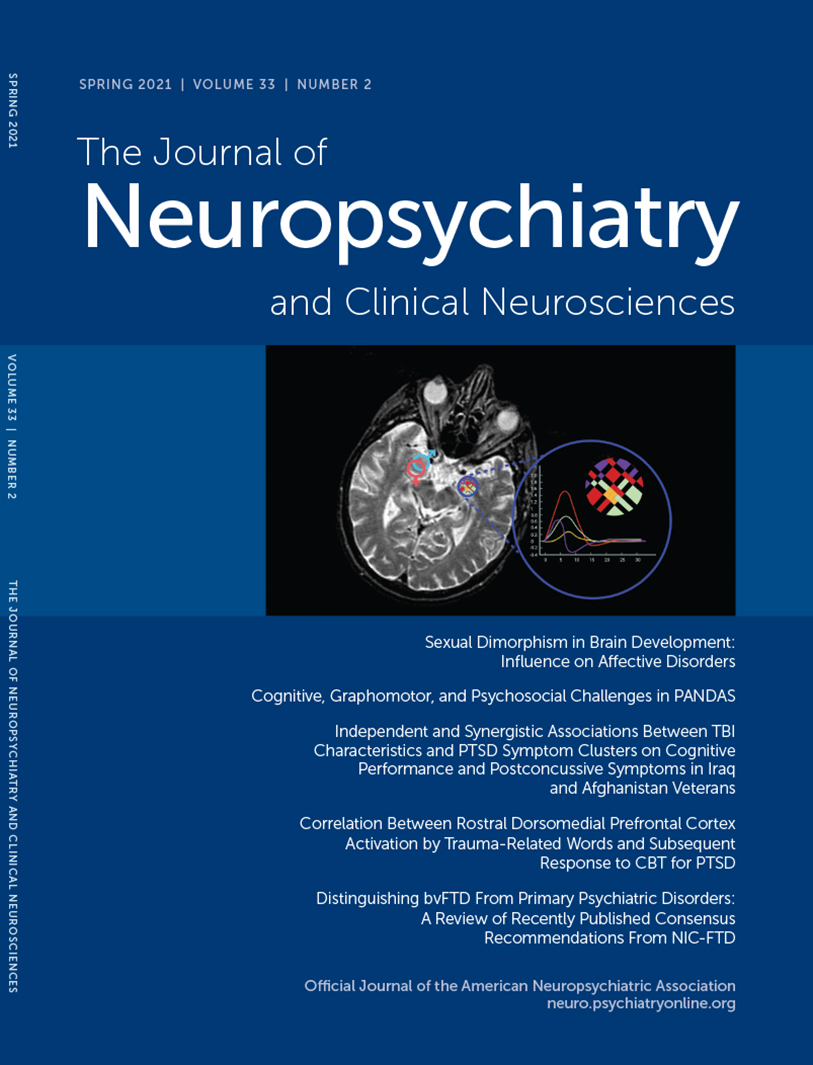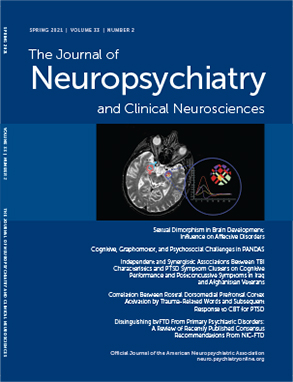Deep brain stimulation (DBS) of the subthalamic nucleus (STN) (STN-DBS) or globus pallidus internus (GPi) can significantly improve the motor symptoms of Parkinson’s disease (PD) (
1,
2). One concern with the neurosurgical procedure and chronic DBS, however, has been the risk of hastening the cognitive decline frequently associated with PD (
3–
6). Currently, there is no consensus on which presurgical characteristics elevate the risk of postoperative cognitive decline after DBS. Identifying these risk factors would inform a more personalized approach to care; in particular, about whether to proceed with surgery and, if so, how to help select the safest surgical approach, target, and stimulation strategy (
7,
8).
Visual illusions or visual hallucinations (VHs) and impulse-control behaviors (ICBs) are two common nonmotor symptoms of PD, particularly after treatment with dopaminergic medications. In our clinic, we anecdotally observed that patients who reported a history of VHs experienced worse cognitive outcomes postoperatively, whereas those with a history of ICBs seemed to remain cognitively stable. Although VHs and ICBs are distinct phenomena, both may reflect unique neural network abnormalities or vulnerabilities and, as such, may provide prognostic information about cognitive outcomes after DBS.
In the case of VHs, prevalence in PD has been estimated at 22%-38% (
9–
12), and they occur on a spectrum from minor illusions to vivid hallucinations (
13,
14). Although their etiology is likely complex (
15–
17), occurrence and progression in severity may be a behavioral marker of a more advanced and widespread neuronal pathology (
18) and have been associated with cognitive changes (
19–
22) and reduced quality of life (
13,
23,
24). This raises important questions about potential cognitive risks of DBS in patients with a history of VHs. Two studies incidentally described that psychosis-like symptoms in the immediate preoperative period appear to be associated with development of postoperative dementia (
25,
26). To our knowledge, no study has systematically explored whether any history of VHs is associated with increased risk of post-DBS cognitive decline.
Motivated by our anecdotal clinical observations and to help clarify whether these common behavioral symptoms of PD and its treatment may reflect vulnerability to post-DBS cognitive decline, we used a retrospective clinical cohort to assess whether any preoperative history of VHs or ICBs was associated with clinically meaningful postoperative cognitive changes. As a secondary analysis, we determined whether cognitive outcomes in such patients differed depending on targeting of STN versus GPi.
Discussion
Using data from a retrospective surgical cohort at an academic medical center, we demonstrated that any preoperative history of VH was significantly associated with worsening of postoperative cognitive performance in attention and executive function in patients with PD receiving DBS. We did not find any such association with a preoperative history of ICBs. Surgical target (STN or GPi) did not affect cognitive outcomes, but increased duration between pre- and postoperative neuropsychological testing was consistently associated with mildly worsened performances on attention and memory tasks.
The notion that neuropsychiatric history might influence DBS outcomes has support in the literature. For example, one study found that patients with active preoperative diagnoses of mood or anxiety disorders had greater improvements in mood after DBS (
38). A unique aspect of our approach, however, was to include any history of VH or ICB, regardless of whether the symptoms were present at the time of DBS surgery. Previous studies of these nonmotor symptoms generally categorized the presence of symptoms only if they occurred during the immediate presurgical period (e.g., 1 week previously for the UPDRS, section I, and 1 month previously for The Neuropsychiatric Inventory Questionnaire). For example, Funkiewiez et al. (
39) utilized the thought disorder question in UPDRS section I (question 2) and identified only three of 70 patients (4%) preoperatively who had experienced hallucinations (or delusions) in the week before surgery. We reasoned that susceptibility to these symptoms, even if caused by dopaminergic medications and resolved after cessation of the causative agents, may imply underlying vulnerabilities in specific brain networks that could portend vulnerabilities for cognitive changes after anesthesia, neurosurgery, chronic brain stimulation, and associated medication changes.
This approach allowed us to identify 15 out of 54 patients (28%) who had ever experienced preoperative VHs and may explain why we were able to detect robust changes in cognition associated with a history of VHs that had been only hinted at in previous reports. Aybek and colleagues (
25), for instance, found that all five (9%) of their initial 57 patients who had endorsed psychosis-like symptoms on their preoperative UPDRS, part I (item 2, score ≥2), were diagnosed with dementia 3 years later. Similarly, Perriol et al. (
26) noted in their study of 58 patients that three out of the four who experienced postoperative cognitive complications had a “history of dopaminergic psychosis,” but this was not further characterized or discussed. Thus, although the use of retrospective chart review and lack of validated instruments to assess for history of VHs (and ICBs) may be considered a limitation, our approach may have identified patients with such a phenotype with greater sensitivity, thereby providing greater statistical power to identify cognitive declines associated with a history of VHs that only had been suggested previously.
Although this finding is concerning and, if replicated, might inform preoperative counseling, risk assessment, improved patient selection, and perhaps even remediation strategies, it is also important to stress that, on average, performance worsened only by less than one-half of one standard deviation in two of the five cognitive domains assessed. Depending on an individual patient’s burden of motor symptoms and overall clinical context, such outcomes may be considered an acceptable tradeoff, and a history of VHs alone does not appear to represent an absolute contraindication to DBS.
One potential concern with our approach was the grouping of patients with a history of illusions together with patients with a history of frank VHs, as considerably less is known about the prognostic implications of milder visual phenomenon (
13). The small number of patients with a history of only illusions precluded analysis of these patients independently. Instead, we performed a sensitivity analysis by removing these patients and rerunning our linear regression models only with those patients with a documented history of frank VHs. We were surprised that removing patients with illusions eliminated the association between VHs and postoperative decline in attention (Tables S4 and S5 in the
online supplement). This sensitivity analysis suggests that the variance is not explained solely by those patients with frank VHs and is consistent with other studies, indicating that even more minor visual phenomena may have clinical and prognostic significance (
13,
23).
Another potential limitation was the possibility that differences in baseline cognition between the groups may explain the detected associations. At preoperative testing, however, the cognitive performance across groups was statistically indistinguishable (Table S1 in the online supplement). To further test the rigor of our approach, we repeated the analyses and included preoperative cognition-by-domain as an additional covariate. This sensitivity analysis did not change the outcome, reinforcing that differences in baseline cognitive performance did not explain our observations.
In the case of history of ICBs, we did not detect a significant post-DBS change in cognition, consistent with a previous report (
31). This is compatible with the idea that ICBs may be attributable in part to iatrogenic overstimulation of the mesocortical and mesolimbic pathways as a consequence of pharmacological attempts to sufficiently augment the nigrostriatal (motor) system, which is then relieved by post-DBS dopaminergic medication reductions. Indeed, in our cohort, a history of ICBs was associated with both a greater preoperative burden of dopaminergic medication and a greater postoperative reduction (
Table 2).
We also wondered whether surgical target might differentially influence results based on neuropsychiatric history, particularly given ongoing debate about putative cognitive differences associated with STN or GPi targeting (
5,
40). We found no support for this idea. However, a major caveat is the nonrandom fashion in which surgical target was determined for each patient. To better understand what bias this might introduce, we subsequently reviewed the documented rationale for GPi targeting in each case. In eight of 12 cases (three of six ICB patients, five of six non-ICB patients), GPi was chosen because of identified preoperative concern about baseline cognition. Thus, if poorer baseline performance implied increased vulnerability and greater risk for further deterioration, then we might have found GPi stimulation to be associated with worsened results in our linear regression model. The fact that cognitive worsening was not explained by the choice of GPi as target could be interpreted as indirect evidence that GPi may be relatively cognitive sparing. Conversely, poorer preoperative performance in some cognitive domains in the GPi subcohort might have resulted in a floor effect that obscured our ability to detect more significant changes between targets. The smaller size of our GPi subcohort, however, combined with our methodological design, ultimately limits any conclusions.
We acknowledge several additional limitations. Although VHs are the most common form of psychotic symptoms in PD, we did not attempt to identify whether patients had delusions or other forms or hallucinations. Furthermore, there may have been unknown bias related to capturing only the patients who returned for follow-up neuropsychological testing, and the homogeneity of the demographics of the cohort and the academic setting may limit generalizability of our results to other populations. Another potential limitation is our lack of outcome data regarding motor symptoms and functional outcomes. As a retrospective study of a clinical population, we found that most patients did not have a documented postoperative UPDRS assessment to quantify motor or functional outcomes near the time of follow-up neuropsychological testing, if at all. As such, we could not adequately include this variable in our analysis, although we do note that postoperative decreases in dopaminergic medications—usually attributable to DBS-related improvement in motor symptoms—were not statistically different among our groups (
Table 2), and past reports have not found a correlation between motor and cognitive outcomes (
26). Nevertheless, we cannot exclude the possibility that motor or functional outcomes may have been different among the groups. Finally, and as noted earlier, identification of a history of VH or ICB was not based on any validated assessments. It is possible that our chart review failed to identify all patients who had ever experienced these symptoms or inaccurately identified patients who did not. Either possibility would result in a diluting of statistical power, and so the fact that we were able to identify significant effects further reinforces the robustness of our findings.
In conclusion, any history of VH during the course of PD may convey prognostic information about post-DBS cognitive risk. Further research is needed to determine whether these findings can be replicated in a larger, more diverse cohort for which motor and functional outcomes (i.e., scores on the UPDRS parts I–IV) are also available for inclusion in the analysis. With few, if any, validated predictors of DBS outcomes beyond preoperative response to levodopa, routine expansion of pre-DBS assessment to a more comprehensive survey of potential neuropsychiatric symptoms may be an important step toward optimizing DBS-related decision making for each individual patient.

